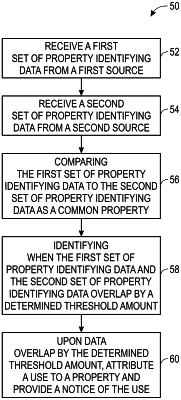| CPC G06Q 50/163 (2013.01) [G06N 5/04 (2013.01); G06Q 30/0645 (2013.01)] | 20 Claims |

|
1. A processor-implemented method for detecting use of a property, comprising:
providing a first request for records in vicinity to a known property address to an application programming interface (API) of a first source comprising a short-term rental web-service that indicates short-term rental use and does not publicly provide an address of a property prior to initiation of a request for use of the property;
in response to providing the first request for records, receiving a first set of property identifying data for a first property from the first source of the short-term rental web-service, via the API;
providing a second request for records specific to the known property address to an API of a second source comprising a second web-service;
in response to providing the second request for records, receiving a second set of property identifying data for a second property from the second source associated with the known property address, via the API;
comparing one or more first property identifying data values of the first set of property identifying data to one or more second property identifying data values of the second set of property identifying data to produce one or more matched property identifying data sets, one or more unmatched property identifying data sets, or both;
assigning one or more weighted values to the one or more matched property identifying data sets, the one or more unmatched property identifying data sets, or both, wherein the one or more weighted values are based on one or more characteristics of the first set of property identifying data;
determining an amount of overlap based on the one or more weighted values of the one or more matched property identifying data sets, the one or more unmatched property identifying data sets, or both;
determining that the amount of overlap does not meet a pre-defined threshold amount;
in response to determining that the amount of overlap does not meet the pre-defined threshold amount, identifying, from a third data source, one or more third property identifying data values associated with the known property address to match with the first property identifying data values to generate one or more higher-weighted matched property identifying data sets;
determining that the amount of overlap in conjunction with the one or more higher-weighted matched property identifying data sets, meets the pre-defined threshold amount;
based upon the amount of overlap meeting the pre-defined threshold amount:
identifying the first property and the second property as a common property;
identifying short-term rental use as a new use at the known property address, by correlating the short-term rental use indicated by the first source with the property address provided by the second source, based upon identifying the first property and the second property as the common property; and
automatically adjusting a service associated with the known property address, based upon identifying the short-term rental use as the new use at the known property address.
|